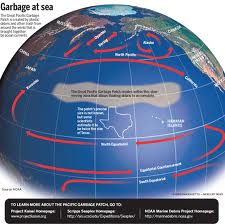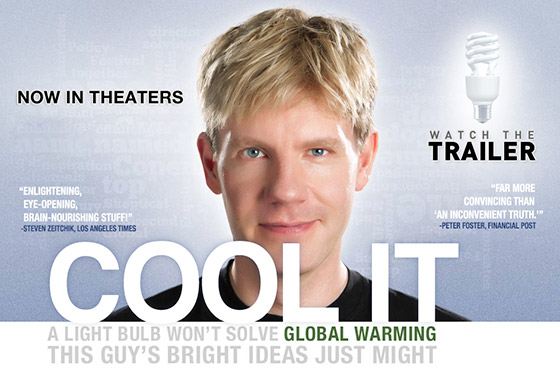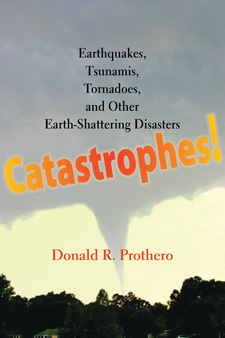by
Donald Prothero, Sep 01 2014

The “Great Pacific Garbage Patch” covers an area many times larger than Texas
When I teach Intro to Oceanography this semester and last year, one of the stories that made the greatest impression on my students (and on me, too) was the sad account of the “Great Pacific Garbage Patch.” This is an area of the ocean surface in the North Pacific covering between 700,000 square kilometers (270,000 sq mi) to more than 15,000,000 square kilometers (5,800,000 sq mi), larger than the size of Texas. It is composed nearly entirely of plastic trash, fishing nets, and other floating garbage, at least 80% which comes from the land and is non-biodegradable. The denser areas of garbage are so large they can be seen from satellite views.
Why is so much garbage concentrated in one area? It all has to do with the oceanic currents that I teach my Oceanography students about. The centers of each portion of the ocean is surrounded by a big circular current called a gyre, which usually runs in a clockwise fashion in the Northern Hemisphere and counterclockwise in the Southern Hemisphere (due to the Coriolis effect). In the North Pacific, a huge gyre completely surrounds the center of the northern ocean, with the warm fast Kuroshio Current coming up from the tropics past Japan, and the cold slow California Current coming down the eastern edge from Alaska, connected by currents (North Equatorial, North Pacific) which travel east or west to connect these in the equator and in the polar regions. This spiraling current tends to accumulate a mound of water in the middle (due to the Ekman spiral effect) that is rather stagnant and does not mix or blend with the boundary currents very well. It is also at a latitude with permanent high-pressure over it, so there’s no strong air currents to move it in any particular direction. Consequently, the centers of ocean gyres are slow and stagnant and tend to accumulate stuff that floats into them, and cannot escape. In the North Atlantic, the stagnant center of the gyre is called the “Sargasso Sea” after the huge floating patches of Sargassum seaweed that floats in the region for decades. There are garbage patches of smaller size in most of the other oceanic gyres as well. But in the North Pacific gyre, what stays put is garbage, the largest such patch in the world. Continue reading…
comments (10)
by
Donald Prothero, Jun 04 2014

A bird dying of oil
Last March was the 25th anniversary of one of the worst environmental disasters in U.S. history: the Exxon Valdez oil spill. It was such a huge leak that it permanently changed the policies of the U.S. Government about shipping oil in U.S. waters, and changed the attitude of many Americans about the risks of huge, hard-to-maneuver supertankers operating in close to shore. More importantly, it galvanized the environmental movement for many years, and forced many Americans to reassess our voracious consumption of oil (even though this was Alaskan oil, not foreign oil). Among U.S. oil spills, only the 2010 BP Deepwater Horizon oil spill was worse in terms of total amount of oil leaked into the ocean.
The facts of the disaster are mostly straightforward. Near midnight on March 24, 1989, the gigantic oil tanker Exxon Valdez was carrying 55 million gallons of crude oil, pumped from up in Prudhoe Bay, Alaska, and then shipped from Valdez Harbor, on its way to Long Beach, California. As it was maneuvering through the rocky waters of Prince William Sound, only the third mate was awake and in control of the ship, and he was sleep-deprived. At 12:04 a.m. in the dead of night, the ship hit Bligh Reef, tore a huge hole in the hull, and immediately began leaking hundreds of barrels of oil. Continue reading…
comments (8)
by
Brian Dunning, Apr 05 2012

An animation I made of the northern end of Santa Catalina Island. The lighter, lower contrast frames were later in the evening. CLICK TO WATCH THE ANIMATION.
One of the benefits of living on the coast is that I’m frequently treated to some amazing mirages out over the ocean. I took the accompanying photographs in February, which is when this phenomenon is most dramatic. It’s the coldest water of the year, with an average temperature of 57F. The average high air temperature is about 69F, and that warmer air is blown out to sea by onshore winds in the afternoon. It’s at this time, when the warmest air is out there around sunset, that the effect appears. Continue reading…
comments (3)
by
Donald Prothero, Mar 21 2012
The recent passing of Sherwood Rowland, who won the 1995 Nobel Prize in Chemistry for his discovery (along with Mario Molina and Paul Crutzen) that CFCs (chlorofluorocarbons) break down ozone in the stratosphere, causes me to think back on that furious debate over environmental issues—and the remarkable way it was resolved by international agreement and no longer threatens us. Those of us who are old enough to remember the political events of the 1970s and 1980s might recall the big public concern over the ozone layer. Like the debate over acid rain, this environmental crisis arose from earlier research that suggested a problem, then ran into huge opposition from conservative business and anti-environmental interests during the 1980s when Reagan’s cronies were in power. Like the debate over acid rain, the evidence for the hole in the ozone layer only increased until the pressure from scientists and governments around the world overcame the resistance of the affected industries, and resulted in an eventual global agreement to curb the causes of this pollution.
The story began in the late 1960s when the U.S. and Europe were both engaged in a race to develop a supersonic transport (SST) for civilian passengers, which would whisk people around huge distances in much shorter times (primarily between Europe and America). I vividly remember this series of events, because my father worked for Lockheed Aircraft at the time, and spent years of his life working very long hours to develop a huge multivolume “proposal” for how the Lockheed SST would be built. Huge numbers of man-hours and millions of dollars building two working prototype aircraft were wasted by Lockheed in the competition when the contract went to Boeing Aircraft instead. Ironically, the Boeing SST was eventually canceled, too. The only SST that was built was the Anglo-French Concorde, which traveled between New York and Paris from 1976 until it was retired in 2003 due to low demand after the 2000 Concorde crash, low air traffic after 9/11, and high costs since most of the electronics in the aircraft were over 30 years old and obsolete. Continue reading…
comments (32)
by
Donald Prothero, May 04 2011
We stand now where two roads diverge. But unlike the roads in Robert Frost’s familiar poem, they are not equally fair. The road we have long been traveling is deceptively easy, a smooth superhighway on which we progress with great speed, but at its end lies disaster. The other fork of the road—the one less traveled by—offers our last, our only chance to reach a destination that assures the preservation of the earth.
—Rachel Carson, Silent Spring
As we marked Earth Day last month, there are disturbing trends of anti-environmentalism running through the political landscape. I distinctly remember the first Earth Day in 1970, and the ensuing decade when the country was very environmentally conscious. But lately, the powerful special interests who oppose environmentalism (especially the oil and coal industries and their lobbyists and politicians) have been fighting hard through the right-wing think tanks that they fund, and through right-wing oil-state politicians like Sarah Palin and James Inhofe, to gut the EPA (created by a Republican president, Richard Nixon) and create doubt and confusion about global climate change (see the discussion in my book Catastrophes!). I shuddered to hear them chant “Drill, baby, drill” at GOP rallies—never mind the fact that the remaining oil reserves in and around the U.S. (including Alaska) are at best enough to last us 2–3 years at our current rate of consumption (ignoring the environmental costs). I never thought I would see the day when people were happy to defend oil spills (like BP’s disaster last summer) and air pollution and strip mining whole mountains for coal as no big deal. But the strangest case of all has to be the weird attempt by right-wing zealots to demonize Rachel Carson.
Rachel Carson has long been considered to be one of the pioneers and a heroine of the environmental movement. Her book Silent Spring (1962) was an environmental classic, and helped galvanize the early environmental movement in the U.S. It popularized the research that showed that DDT sprayed indiscriminately to kill mosquitoes was also killing a wide variety of other harmless wildlife. In particular, DDT was destroying bird populations because of the increasing concentrations of the poison as it went up the food chain, so that apex predators like hawks, falcons and eagles were dying off at alarming rates. Historians regard the banning of DDT as an early environmental success story. At the time, the ban had widespread support from both Republicans and Democrats in Congress, and DDT was finally made illegal under Nixon’s Republican administration. Carson herself died in 1964, too soon to see how her efforts led to the banning of DDT and the birth of the EPA and Environmental Defense Fund and many other environmental movement organizations. Continue reading…
comments (71)
by
Michael Shermer, Nov 16 2010
This post is a review of Cool It, a film by Bjorn Lomborg, directed by Ondi Timoner, produced by Roadside Attractions and 1019 Entertainment. Written by Terry Botwick, Sarah Gibson, and Bjorn Lomborg. Based on the book by Bjorn Lomborg. 88 minutes.

I FIRST MET BJORN LOMBORG IN 2001 upon the publication of his Cambridge University Press book, The Skeptical Environmentalist, which I found to be a refreshing perspective on what had been the doom-and-gloom, end-of-the-world scenarios that I had been hearing since I was an undergraduate in the early 1970s. Back then we were told that overpopulation would lead to worldwide hunger and starvation, that there would be massive oil depletion, precious mineral exhaustion, and rainforest extinction by the 1990s. These predictions failed utterly. I felt I had been lied to for decades by the environmentalist movement that seemed to me to be little more than a political movement that raised money by raising fears. Continue reading…
comments (259)
by
Brian Dunning, Mar 25 2010
I’ve been a Scientific American reader ever since I picked one up in my twenties at the home of my girlfriend’s parents (now my wife’s), as her dad was an exec at Hughes Space Systems and a top expert in photovoltaics. But I have to say, lately they’ve run a few opinion articles that I can’t completely agree with, focusing on energy. They seem to have adopted a clearly anti-nuclear bias (anyone who listens to my podcast knows that I’m a big nuclear fan), and are even critical of fusion research. The April 2010 issue features an article by Bill McKibben, scholar in residence at Middlebury College, and from what I can tell, something of a Luddite, not that there’s anything wrong with that. It smacks of a disturbing trend I see a lot of lately, where anticorporatism (which is as worthy a philosophy as any) is greenwashed with a supposedly environmental, scientific agenda (which is dishonest and does a disservice). We should not make science decisions that promote our favorite philosophies, we should make science decisions that best serve our planet and our people. They may coincide in many cases, but they don’t always. Here is a snip from a sidebar in McKibben’s article:
Job one, on almost anybody’s list, is conservation. The consulting firm McKinsey & Company estimated in 2008 that existing technologies could cut world energy demand 20 percent by 2020. For supply, it makes financial sense to generate power close to home. Most communities spend 10 percent of their money for fuel, and almost all of it disappears, off to Saudi Arabia or Exxon. Yet in 2008 the Institute for Local Self-Reliance showed that nearly half of all American States could meet their energy needs entirely within their borders, “and the vast majority could meet a significant percentage.” Wind turbines and rooftop solar could provide 81 percent of New York’s power, for instance, and almost one third of Ohio’s.
I’ll begin by stating that McKibben and I agree in principal almost entirely. We do need to completely replace our fossil fuel driven power grid, and as quickly as possible. With that said, I disagree with virtually every single point he makes. Let’s go one by one: Continue reading…
comments (58)
by
Brian Dunning, Oct 22 2009
Reader Ryan Quick is a member of the Yahoo! Group EastRangeFreecycle, a northern Minnesota chapter of Freecycle. Freecycle (http://freecycle.org/) is a fine, nonprofit association of groups where items can be given away for free rather than having them go into a landfill. I’ve never used their service, but I’m a strong proponent of the philosophy and have given away a number of items over the years, mostly furniture.
Someone offered the following item for free on the list:
Offer: Natural Cures “They” Don’t Want You to Know About
By Kevin Trudeau. Excellent book – I just have two of them.
In Virginia.
Continue reading…
comments (17)
by
Michael Shermer, Sep 29 2009
Are you a global warming skeptic, or are you skeptical of the global warming skeptics? Your answer depends on how you answer these five questions:
- Is the earth getting warmer?
- Is the cause of global warming human activity?
- How much warmer is it going to get?
- What are the consequences of a warmer climate?
- How much should we invest in altering the climate? Here are my answers.
Global warming is real and primarily human caused. With questions 3 and 4, however, estimates include error bars that grow wider the further out we run the models because complex systems like climate are notoriously difficult to predict. I provisionally accept the estimate of the United Nations’ Intergovernmental Panel on Climate Change (IPCC) that the mean global temperature by 2100 will increase by 4.7 degrees Fahrenheit, and that sea levels will rise by about one foot (about the same as they have risen since 1860). Moderate warming with moderate changes. Continue reading…
comments (181)





